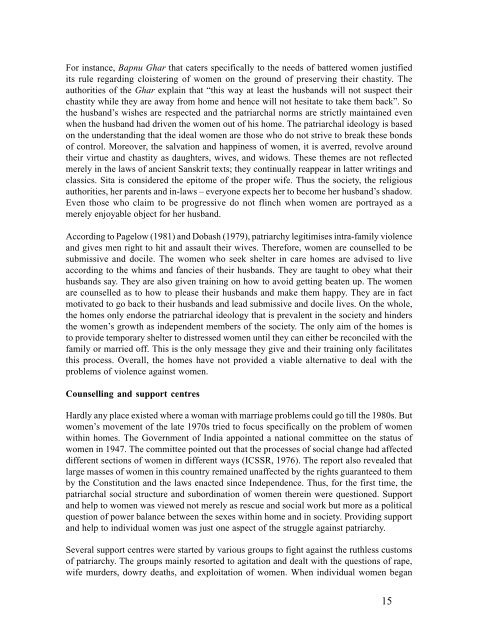Destitute Women in Kerala: Psychological resources and psycho ...
Destitute Women in Kerala: Psychological resources and psycho ...
Destitute Women in Kerala: Psychological resources and psycho ...
You also want an ePaper? Increase the reach of your titles
YUMPU automatically turns print PDFs into web optimized ePapers that Google loves.
For <strong>in</strong>stance, Bapnu Ghar that caters specifically to the needs of battered women justified<br />
its rule regard<strong>in</strong>g cloister<strong>in</strong>g of women on the ground of preserv<strong>in</strong>g their chastity. The<br />
authorities of the Ghar expla<strong>in</strong> that “this way at least the husb<strong>and</strong>s will not suspect their<br />
chastity while they are away from home <strong>and</strong> hence will not hesitate to take them back”. So<br />
the husb<strong>and</strong>’s wishes are respected <strong>and</strong> the patriarchal norms are strictly ma<strong>in</strong>ta<strong>in</strong>ed even<br />
when the husb<strong>and</strong> had driven the women out of his home. The patriarchal ideology is based<br />
on the underst<strong>and</strong><strong>in</strong>g that the ideal women are those who do not strive to break these bonds<br />
of control. Moreover, the salvation <strong>and</strong> happ<strong>in</strong>ess of women, it is averred, revolve around<br />
their virtue <strong>and</strong> chastity as daughters, wives, <strong>and</strong> widows. These themes are not reflected<br />
merely <strong>in</strong> the laws of ancient Sanskrit texts; they cont<strong>in</strong>ually reappear <strong>in</strong> latter writ<strong>in</strong>gs <strong>and</strong><br />
classics. Sita is considered the epitome of the proper wife. Thus the society, the religious<br />
authorities, her parents <strong>and</strong> <strong>in</strong>-laws – everyone expects her to become her husb<strong>and</strong>’s shadow.<br />
Even those who claim to be progressive do not fl<strong>in</strong>ch when women are portrayed as a<br />
merely enjoyable object for her husb<strong>and</strong>.<br />
Accord<strong>in</strong>g to Pagelow (1981) <strong>and</strong> Dobash (1979), patriarchy legitimises <strong>in</strong>tra-family violence<br />
<strong>and</strong> gives men right to hit <strong>and</strong> assault their wives. Therefore, women are counselled to be<br />
submissive <strong>and</strong> docile. The women who seek shelter <strong>in</strong> care homes are advised to live<br />
accord<strong>in</strong>g to the whims <strong>and</strong> fancies of their husb<strong>and</strong>s. They are taught to obey what their<br />
husb<strong>and</strong>s say. They are also given tra<strong>in</strong><strong>in</strong>g on how to avoid gett<strong>in</strong>g beaten up. The women<br />
are counselled as to how to please their husb<strong>and</strong>s <strong>and</strong> make them happy. They are <strong>in</strong> fact<br />
motivated to go back to their husb<strong>and</strong>s <strong>and</strong> lead submissive <strong>and</strong> docile lives. On the whole,<br />
the homes only endorse the patriarchal ideology that is prevalent <strong>in</strong> the society <strong>and</strong> h<strong>in</strong>ders<br />
the women’s growth as <strong>in</strong>dependent members of the society. The only aim of the homes is<br />
to provide temporary shelter to distressed women until they can either be reconciled with the<br />
family or married off. This is the only message they give <strong>and</strong> their tra<strong>in</strong><strong>in</strong>g only facilitates<br />
this process. Overall, the homes have not provided a viable alternative to deal with the<br />
problems of violence aga<strong>in</strong>st women.<br />
Counsell<strong>in</strong>g <strong>and</strong> support centres<br />
Hardly any place existed where a woman with marriage problems could go till the 1980s. But<br />
women’s movement of the late 1970s tried to focus specifically on the problem of women<br />
with<strong>in</strong> homes. The Government of India appo<strong>in</strong>ted a national committee on the status of<br />
women <strong>in</strong> 1947. The committee po<strong>in</strong>ted out that the processes of social change had affected<br />
different sections of women <strong>in</strong> different ways (ICSSR, 1976). The report also revealed that<br />
large masses of women <strong>in</strong> this country rema<strong>in</strong>ed unaffected by the rights guaranteed to them<br />
by the Constitution <strong>and</strong> the laws enacted s<strong>in</strong>ce Independence. Thus, for the first time, the<br />
patriarchal social structure <strong>and</strong> subord<strong>in</strong>ation of women there<strong>in</strong> were questioned. Support<br />
<strong>and</strong> help to women was viewed not merely as rescue <strong>and</strong> social work but more as a political<br />
question of power balance between the sexes with<strong>in</strong> home <strong>and</strong> <strong>in</strong> society. Provid<strong>in</strong>g support<br />
<strong>and</strong> help to <strong>in</strong>dividual women was just one aspect of the struggle aga<strong>in</strong>st patriarchy.<br />
Several support centres were started by various groups to fight aga<strong>in</strong>st the ruthless customs<br />
of patriarchy. The groups ma<strong>in</strong>ly resorted to agitation <strong>and</strong> dealt with the questions of rape,<br />
wife murders, dowry deaths, <strong>and</strong> exploitation of women. When <strong>in</strong>dividual women began<br />
15










